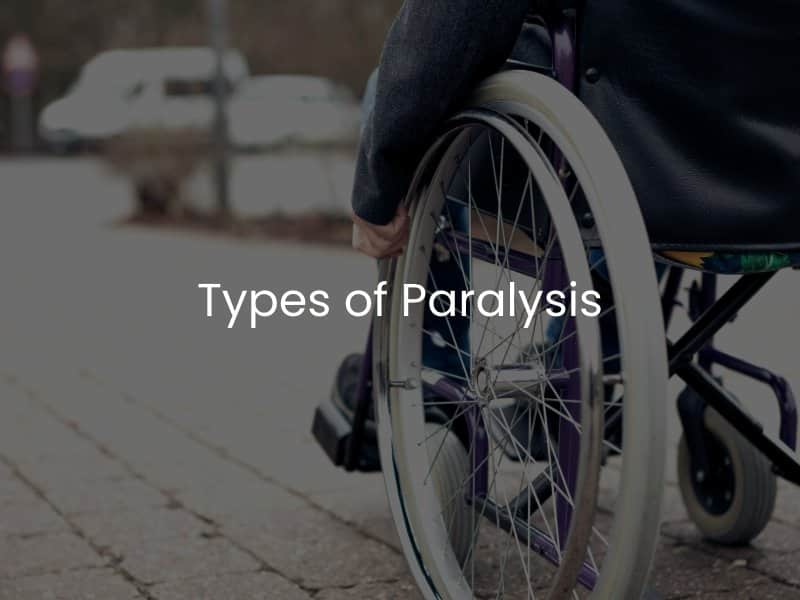Types of Paralysis
Paralysis can be detrimental for a victim. Unfortunately, there are various ways that a person can become paralyzed due to the careless or negligent actions of another individual, business, or entity. One of the most common causes of paralysis is vehicle accidents. However, traumatic injuries are certainly not the only way that a person can become paralyzed.
Most people do not know that there are various types of paralysis that can occur.

How Does Paralysis Occur?
When we discuss paralysis, it is often assumed that people become paralyzed because of the direct result of some sort of trauma. However, that is not necessarily the case. Some of the most common causes of paralysis include the following:
- Cerebral palsy
- Other types of birth injuries
- Brain injuries
- Cerebrovascular incidents (including strokes)
- Spinal cord injuries
In general, we can look at this list and see that many of the causes of paralysis are nobody’s fault. However, there are often times when the careless or negligent actions of other individuals can lead to paralysis.
If we look at information available from the National Spinal Cord Injury Statistical Center (NSCISC), we can see that there are around 288,000 people living in the US with disabilities caused by spinal cord injuries. In general, we see that more than 17,000 new spinal cord injuries occur each year. During the last few years of data collected by the NSCISC, we can see that the most traumatic incident common causes of spinal cord injuries include the following:
- Vehicle accidents
- Falls
- Violence (gunshots, assaults, etc.)
- Sports and recreation incidents
- Medical or surgical mistakes
Types of Paralysis
The types of paralysis a person experiences will depend heavily on the severity of the incident that originally caused the injury. These are the four levels of paralysis a person can sustain:
- Monoplegia. This refers to paralysis that occurs in a single part of a person’s body. If a person has monoplegia, they usually have full functioning of every other limb, but they will not be able to move or feel the affected limb. We will find that monoplegia is typically caused by strokes, brain injuries, or cerebral palsy. Monoplegia is not always permanent, and there are times when a person can regain the use of the affected limb through physical therapy.
- Hemiplegia. This type of paralysis will typically impact an arm and leg on one side of a person’s body. In fact, the term “hemi” means half. Hemiplegia is not always a permanent condition. The intensity varies greatly depending on what actually caused the hemiplegia in the first place. Often, this type of paralysis begins with the person feeling needles in the affected area that slowly turned into paralysis.
- Paraplegia. This refers to the type of paralysis a person experiences from the waist down. Any person suffering from paraplegia likely has lost control of both legs and their hips. Additionally, paraplegia victims often suffer from sexual dysfunction and problems with waste management. Paraplegia is often caused by a spinal cord injury that subsequently affects a person’s brain’s ability to send and receive signals to the lower area of the body. However, brain injuries, infections, and tumors can also cause paraplegia.
- Quadriplegia. This is the most serious form of paralysis, and this affects injury victims from the neck down. “Quad” refers to four, which means a person typically loses control of all limbs and their torso. The severity of quadriplegia does vary from person to person, and there are instances where individuals can regain some parts of movement in their body through physical therapy and other medical care. Spinal cord injuries are the leading cause of quadriplegia in victims, though there are other causes, including traumatic brain injuries, drug overdoses, allergic reactions to medications, lack of oxygen to the brain, etc.
The Cost of Paralysis for Victims
There are various factors that need to be examined when determining the costs of paralysis on victims. First, we can evaluate costs while specifically looking at the medical care that will be required. Please understand that any figures that we give you will vary depending on how a person becomes paralyzed and the level of care that they need.
Data available from the NSCISC shows that the first year of care after a person sustains a spinal cord injury generally ranges from $370,000 to more than one $1,000,000. Every subsequent year of medical care could reach costs ranging from $44,000 to more than $200,000. However, these figures refer only to those who sustain traumatic spinal cord injuries and are paralyzed. This data does not include the cost of care related to other causes of paralysis. In general, though, any type of paralysis is going to cost victims a significant amount of money when it comes to medical bills.
When we are examining the total costs caused by paralysis, we have to look away from just medical bills. Victims and family members can face a range of other expenses related to these incidents. These other costs can include:
- Lost wages if a victim or their family member can no longer work
- General household out-of-pocket expenses that arise due to the injury
- The cost of travel to and from spinal cord injury/paralysis specialists
- Cost of construction to modify a home to aid with mobility
- The cost of vehicles specifically suited for paralysis victims
- The cost of any necessary medical devices
In addition to these direct economic losses, we also have to consider the profound effect that the paralysis will have on the mental and emotional well-being of injury victims and their family members. When a person is paralyzed, this will result in significant life changes for every party involved. Regardless of the type of paralysis a person sustains, there will be a significant adjustment period.